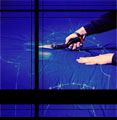![]()
Shut your eyes,
and for a moment remember the best bar and beverage that you have ever experienced.
What was it like? What made that experience
the best? What elements collided to create your experience?
Did you
saunter with socialites and their "Grey Goose martinis, extra dry, shaken
not stirred, with a zest?" Or was "slumming it" with a couple
of Lone Star beers at your local dive more your style? Did go-go dancers
rain from the sky under the stars of colored lights, or did the Johnny
Walker Green Label simply rain from your own personal bar under the stars
of your own back porch?
Regardless of the circumstances recounted, I'm willing to bet
that many elements came together that evening to make the complete experience.
For example, take the following items.

1. glass
2. ice
3. tonic
4. gin
combine.

1. gin and tonic
When mixed correctly,
the action of combining of the separate and distinct entities creates
a superior entity. In other words, if you mix the right things together,
you will end up with something better
than the sum of the seperate parts.
According to the Oxford English Dictionary, mixology is defined as: the art of mixing drinks.
OPUS is an example of what I call Academic Mixology. Academic Mixology might be defined as: the reorganization, reclassification, and recombination of academic disciplines. Academic Mixology lives amongst dominant practices, emergent culture, historical reflexivity and technological augmentation. Academic Mixology integrates multiple disciplines. In the case of OPUS, these included art, architecture, fashion, music, film, social science, subculture and street culture. I collected images and works that would influence the production and would reveal the underpinnings of its Mix.

Further Readings.
Barnett
Newman.
Newman, Barnett. Barnett Newman.
McNickle, Mollie. The mind and art of Barnett Newman.
Ward, O. Perfection Unzipped. Art Review v.53. pg.40.
Zweite, Armin. Barnett Newman: Paintings, sulptures, works on paper.
Dan Flavin.
Irvine. Five sculptors: Andre, Flavin, Judd, Morris, Serra.
Flavin, Dan. The architecture of light.
St. Louis Art Museum. Drawings and diagrams, 1963-1972.
FRAME. The
International Magazine of Interior Architecture and Design. pg38-74.Mar/Apr 2002.
Donald
Judd.
Ostfildern-Ruit. Donald Judd, colorist.
Judd, Donald. Donald Judd furniture:retrospective.
Judd, Donald. Complete writings, 1975-1986.
Sudjic, D. Marfa, Texas: Judd and Flavin's dream. Domus no.832.
Ellsworth Kelly.
Hickey, Dave. Ellsworth Kelly: New paintings.
Kelly, Ellsworth. Line, form,color.
Kelly, Ellsworth.Parkett 1999.
Fashion
Shows.
Goschie, Susan.
Fashion direction and coordination.
Guerin, Polly.
Creative fashion presentations.
Interdisciplinarity
Deleuze, Gilles. A Thousand Plateaus: capitalism and schizophrenia.
Hofstadter, Douglas R. godel, Escher, Bach: an eternal golden braid.
Lynn, Greg. Animate form.
Trasi,
Nicoletta. Interdisciplinary architecture.
Zetti, Herbert.
Sight, sound, motion: applied media aesthetics.
Minimalism.
Batchelor, David. Minimalism.
Battcock, Gregory. Minimal Art; a critical anthology.
Meyer, James Sampson. The genealogy of minimalism: Carl Andre, Dan Flavin,
Donald Judd, Sol LeWitt and Robert Morris.
Washington gallery of Modern Art. A new Aesthetic. (exhibition) May 6-June
25, 1967.